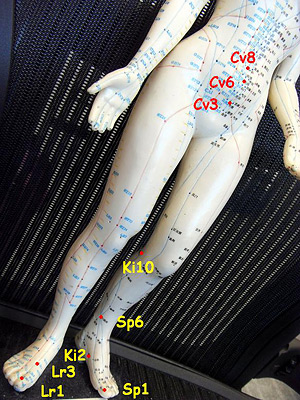Acupuncture and Moxibustion for Dysfunctional Uterine Bleeding (DUB)
Acupuncture and moxibustion can deliver desirable results to menstrual disturbances, and are commonly used for treating various health issues specific to women. The therapies activate energy flow (qi) in the meridians, induce contractions of the uterus and blood vessels, and promote ovarian functioning, which help control dysfunctional uterine bleeding. Physicians will use acupuncture and moxibustion methods to replenish qi, consolidate the conception vessel and thoroughfare vessel meridians, and cool blood, so as to restore normal periods and stop bleeding. Major body points are usually selected along the spleen meridian and the conception vessel. Below are suggested acupuncture and moxibustion prescriptions for dysfunctional uterine bleeding.
1. Shen que (Cv8) and yin bai (Sp1), moxa heating for 20 to 30 minutes.
Shen que (Cv8) belongs to the conception vessel meridian, stimulating the point promotes uterine contraction and stops bleeding. Yin bai (Sp1) is the well point of the spleen meridian, stimulating the point invigorates the spleen to govern the movement of blood. These two points can be used to treat excessive vaginal bleeding in various conditions, especially for those have qi deficiency signs.
2. Qi hai (Cv6), da dun (Lr1), yin gu (Ki10), tai chong (Lr3), ran gu (Ki2), san yin jiao (Sp6), zhong ji (Cv3)
In this prescription, qi hai (Cv6) and da dun (Lr1) are the major points.
 |
Qi hai (Cv6): replenishes primordial energy, consolidate the conception vessel and thoroughfare vessel meridians; |
 |
Da dun (Lr1): the well point of the liver meridian, stimulating the point promotes the liver to regulate blood flow and blood storage inside the body. Applying moxa heating on it can also enhance qi circulating and regulate the thoroughfare vessel meridian and stop bleeding; |
 |
Yin gu (Ki10): invigorates the kidneys and strengthens the above two meridians; |
 |
Tai chong (Lr3): soothes the liver and regulate qi flow which can further enhance the effects of qi hai (Cv6); |
 |
Ran gu (Ki2): clears the heat in the uterus; |
 |
San yin jiao (Sp6) & zhong ji (Cv3): unblock the blood vessels of the uterus, resolve stasis and stop bleeding. |
Additional body points can be selected according to the disharmony patterns.
 |
Excessive heat: xue hai (Sp10), qu chi (Li11), xing jian (Lr2), xia xi (Gb43), & nei ting (St44) |
 |
Blood stasis: he gu (Li4), xue hai (Sp10), gui lai (St29), tan zhong (Cv17), & zi gong (Ex-ca1) |
 |
Kidney deficiency: shen shu (Bl23), ming men (Gv4 ), guan yuan (Cv4), & shen que (Cv8) |
 |
Spleen deficiency: zu san li (St36), ge shu (Bl17), xue hai (Sp10), guan yuan (Cv4), & pi shu (Bl20) |
The therapies should begin one week after the menstrual flow ends, and usually last for three cycles.
 |
Acupuncture points for dysfunctional uterine bleeding |
|